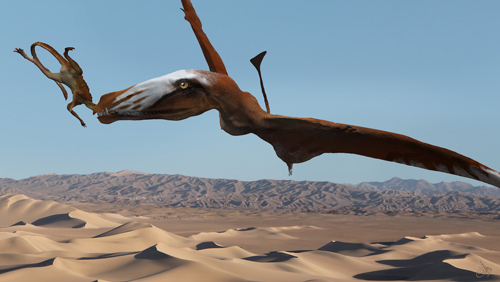New Pterosaur Genus Discovered in Utah
Much excitement was generated at the annual Society of Vertebrate Palaeontology conference in Dallas (Texas), when Brooks Britt, an Associate Professor of Geology at Brigham Young University (Utah) updated the audience on a remarkable fossil discovery from north-eastern Utah, close to the State border with Colorado. During the Late Triassic, the western part of North America was covered in vast sand dunes. The area resembled the Sahara of today. Just like in the Sahara, there were pockets of life clustered around water sources.
Associate Professor Britt and his colleagues have for some years now been excavating the fossilised remains of fauna that lived around an oasis approximately 210 million years ago. For these residents, surrounded by the desert, their collective luck ran out when during a severe drought the water evaporated and much of this ancient ecosystem was wiped out. The bad luck of the Triassic animals is good fortune for palaeontologists as they have been able to piece together a remarkable picture of the fauna of this Late Triassic oasis.
Triassic Pterosaur
One of the most impressive discoveries made so far, came in 2014. The quarry known as the Saints and Sinners Quarry had been explored for more than a decade. The beds that make up the quarry are fossiliferous as they represent lake shoreline sediments, rocks laid down at an oasis that was surrounded by vast desert dunes. Brigham Young University student Scott Meek unearthed from the sandstone the partial remains of a pterosaur.
Pterosaur fossils from the Late Triassic and Early Jurassic are rare in North America. The specimen has yet to be formally described and named but it does represent a new species (most likely a member of the Dimorphodontidae family or possibly ancestral to this pterosaur family).
An Concept Drawing of the New Late Triassic Pterosaur from Utah
Picture credit: Josh Cotton
Although not large when compared to later members of the Pterosauria, the Utah specimen had a wingspan of around 1.3 metres, making it about the size of a modern day European Herring Gull (Larus argentatus). It had a large head and a jaw lined with over one hundred pointed teeth (110 in total).
Fangs on a Triassic Pterosaur
Four of the teeth, located towards the front of the lower jaw were more like fangs. The largest of them measures 2.5 centimetres long. This is one pterosaur that would have looked very mean indeed! The orbits (eye-sockets) are smaller than seen in other members of the Dimorphodontidae family, perhaps as this flying reptile lived in a very bright and sunlit environment with lots of glare from the surface of the lake and the surrounding desert it may have evolved smaller eyes to help protect its vision from the excessive bright light, although this is only speculation on our part and we await with interest the scientific paper on the pterosaur specimen that will probably be published next year.
A Triassic Oasis – Teeming with Life
Associate Professor Britt specialises in studying sediments. These sediments help to build up a picture of the climate and the environment at the time. These sandstones have also revealed what happened to the animals that depended on the oasis and why the fossil assemblage came to be formed, Brooks Britt explained:
“The animals likely died during a severe drought, and the sediments indicate their carcasses were buried when the rains returned to normal and the lake filled, with the lapping waves burying the bones with sand.”
The fossil is also relatively three-dimensional. Most pterosaur fossil bones are easily crushed and distorted. Associate Professor Britt added:
“Outside of a find in Greenland, this is the first good Triassic pterosaur from North America.”
The scientists also found a wealth of other vertebrate fossils, including at least twenty individual Coelophysoid theropod specimens, plus the teeth of a much more substantial meat-eating dinosaur. In addition, cursorial crocodylomorph fossils (the victim in the pterosaur illustration), along with evidence of sphenosuchians and a drepanosaurid, a representative of a bizarre group of Late Triassic reptiles that may have been arboreal, were discovered.
Why Didn’t the Pterosaur Fly Away?
All the other vertebrate fossils found at the dig site are from entirely terrestrial animals. These animals would have been effectively trapped by the desert and not capable of travelling the distance required to find a new habitat when the oasis began to dry up, but why didn’t the pterosaur just fly away? Perhaps other pterosaurs were able to leave and this fossil represents an old or sick individual.
Or alternatively, the shape of the pterosaur’s wings may provide a clue. The wings of this creature are relatively short and broad, suggesting that they were not adapted to long distance flight.
These wings are more suited to short flights with the need to dodge and to weave, perhaps round obstacles such as trees. This new pterosaur may have been an agile flier well suited to a life hunting in the trees close to the lake, but once the lake dried up, it may not have been capable of travelling the large distance required in order to find a new home.
We look forward to reading more about the “Saints and Sinners” pterosaur in 2016.
For scale models of pterosaurs and other prehistoric animals: CollectA Deluxe Scale Prehistoric Animal Models.







Leave A Comment